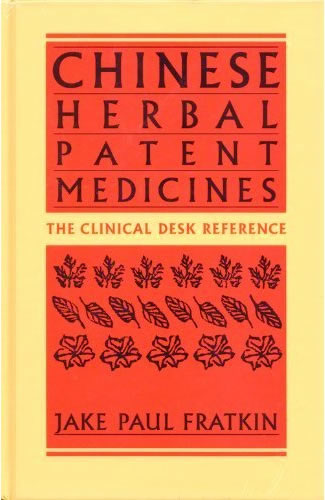Review: Chinese Herbal Patent Medicines: The Clinical Desk Reference
Reviewed by Sacred Lotus on: 03/04/2013
There are thousands of Chinese herbal patent medicines from different manufacturers available in the United States. While Fratkin's clinical desk reference is an older book (2001), it is still my personal favorite for referencing any of the bottled/packaged Chinese medicines. There has only been a handful of times that I have not been able to reference an off-the-shelf Chinese patent medicine (i.e. - an obscure Chinese patent bottle brought in by a patient).
The book covers over 1,300 products, with 109 chapters, and has color photos for most of the patent medicines in the book. The table of contents is broken down nicely into 12 categories of TCM disorders. There is author's commentary on each section, where he introduces the TCM theory behind the patterns and medicines. There is also an extensive appendix of symptoms and diseases, enabling you to quickly reference off-the-shelf medicine for a particular TCM pattern within each disorder category.
The Chinese patent formulas can be looked up by either English or Pinyin indices. If you still can't find the medicine, you can browse through almost 1,000 photos of the product bottles/packages. The book also has appendices to look up the herbs by Chinese characters, pharmaceutical, botanical, and common names.
Each medicine includes:
- Actions/Indications
- Origin of the Formula
- Author's Comments/Notes
- Cautions (if any)
- Research (if any)
- Laboratory Analysis and Purity (if any)
- Legality/Endangered Species (if any)
- Ingredients (if known)
- Packaging and Dosage
One of my favorite aspects of the 'Clinical Desk Reference' is that includes relevant clinical research on the medicines. For instance, 'Xiao Yao Wan' (Free and Relaxed Pills) contains the results of a study on 253 acute hepatitis patients taking the patent, with a general effective rate of 69%.
Another important aspect of the book is that California FDB (Food and Drug Branch) analysis was performed on over 500 products in the book. And, if available, each patent medicine contains information on whether the sample contained heavy metals and/or pharmaceuticals. Certain patents for example had toxic levels of arsenic, mercury, lead, etc. Other medicines contained western drugs, chemical preservatives, dyes, etc.
Other important information on each patent medicine is whether it contains endangered animal products (and illegal); such as tiger bone, rhinoceros horn, bear gallbladder, wild musk deer gland, antelope horn, crocodile gallbladder, sea horse, leopard bone, pangolin anteater scales, wild seal penis, monkey gallstones, etc.
In closing, I would like to note that there are plenty of very safe and effective Chinese herbal patent formulas available today. This book (and others) undoubtedly inspired stricter manufacturing processes, tighter control, better regulation, and awareness and advocacy about the contents of imported Chinese medicines.
Go check out "Chinese Herbal Patent Medicines: The Clinical Desk Reference
"...

